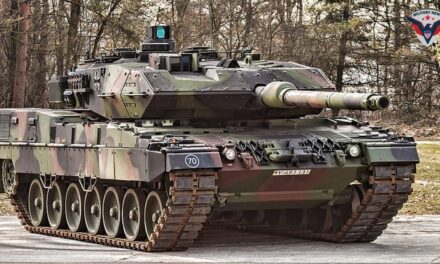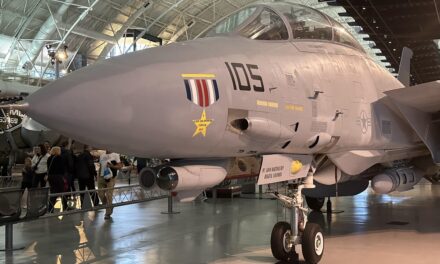We support our Publishers and Content Creators. You can view this story on their website by CLICKING HERE.
Key Points: The U.S. Air Force’s Next-Generation Air Dominance (NGAD) program, envisioned as a revolutionary 6th-generation fighter, was born from a DARPA-led initiative in 2014 to replace the F-22 Raptor.
-Designed to feature enhanced stealth, unmatched dogfighting capabilities, and integration with drones, NGAD faces challenges of high costs ($300M per unit) and complex technological demands, including advanced engines and materials.
-Despite its current “operational pause,” historical studies like the Air Superiority 2030 Flight Plan emphasized NGAD’s necessity to counter future threats from Russia and China. If successful, NGAD could reshape aerial combat strategy for decades.
The U.S. Air Force’s Efforts to Make History: Background on the NGAD Fighter
We often analyze the U.S. Air Force’s Next-Generation Air Dominance (NGAD) fighter here at 19FortyFive. It is an expensive 6th-generation fighter that will have better stealth attributes, enviable firepower, and excellent dogfighting skills. However, the NGAD program is on “operational pause” due to its high price of $300 million per unit and its unknown design characteristics.
It will need a new engine to power its supposed unlimited dogfighting skill and use it as a mothership for drones.
Let’s take a historical look at this program to see whether it has the potential to take flight some day and replace the F-22 Raptor fighter.
DARPA Takes a Long Look
It shouldn’t surprise us that the NGAD was spawned by the secretive and uber-innovative Defense Advanced Research Projects Agency.
In 2014, DARPA engineers and designers wanted something to replace the F-22 Raptor that would build on the 5th generation airplane’s stealth characteristics and multi-role aspects that included excellent aerial combat and ground strike capability.
They sought to improve the F-22’s maneuverability and air superiority. DARPA conducted the feasibility study and recommended that the Air Force proceed with a sixth-generation fighter.
Answering the Main Question on NGAD
However, the unanswered question was, how would the NGAD be built?
No one wanted to replicate the F-35 program, which the most expensive major end item in history. The F-35 engine has always been problematic. And the Air Force didn’t know if the NGAD would be exported to other countries someday. Plus, just how would all the great aspects of the future jet be added to an airframe whose design was up in the air.
The stealth coating would be difficult. Would the Air Force find engineers who were expert in next-generation materials science? DARPA could have recommended that the Air Force use a coating that incorporated principles from nanotechnology like carbon nanotubes to increase stealthiness.
What kind of engine would be used? It would have to be powerful and not overheat during high-octane maneuvers that would make it more survivable. The NGAD would need to have software that was updatable so the Air Force would have another “flying computer.” Then there was the “Loyal Wingman” concept that would have combat drones digitally tethered to the NGAD – what the Air Force would later call Collaborative Combat Aircraft. All of those needed to be designed from scratch.
It’s Not a Plan Unless It is Written Down
These were all aspects to be pondered in the 2014 Air Dominance Initiative Study. Once DARPA completed this research it looked even further into the future. If the NGAD was designed, how would it fit into the aerial combat strategy of the 2030s? The F-22 would have to be replaced, but the NGAD would need to fly and communicate with the F-35 that is predicted to be deployed by the U.S. military for several more decades. The Air Force wanted a deeply-analytical and decisive plan for the future that would tie all of its airplanes together into an overarching strategy. The future B-21 Raider was considered as the B-52, B-1, and B-2 were becoming older and needed to be upgraded. Could the NGAD and the B-21 fly missions together?
So, the Air Force issued another report. It was called the “Air Superiority 2030 Flight Plan.” The Secretary of the Air Force called for it in 2016. It aimed to answer the issues and questions I raised above. The team in charge of the study (the Enterprise Capability Collaboration Team) knew that the 2030s would be highly contested. Russia had taken over Crimea and parts of Ukraine. China was belligerent against its neighbors and was militarizing various rocks and reefs in the East and South China Sea, and there could always be an attack or blockade against Taiwan. The team had its work cut out for it.
What Is Air Superiority in the 2030s?
The report was ambitious. The authors said that “air superiority provides freedom from attack, freedom to attack, freedom of action, freedom of access, and freedom of awareness. Importantly, it also precludes adversaries from exploiting similar advantages. As such, air superiority underwrites the full spectrum of joint military operations and provides an asymmetric advantage to friendly forces. A lack of air superiority significantly increases the risk of joint force mission failure as well as the cost to achieve victory both in terms of resources and loss of life.”
This Looked Exciting
Wow! You can see that the Air Force envisioned the NGAD to be something special. Russia looked like it was going toward all-out war with the Ukrainians. China was using the anti-access area denial strategy against the United States. The Air Force needed a new airplane that was going to answer these contingencies.
The report said that the branch needed to devise the best in the following attributes, “Basing and Logistics; Find, Fix, Track and Assess; Target and Engage; and Command and Control.”
Could the NGAD deliver on its promises? This report certainly was optimistic. However, papers and strategy documents are often not read. But I would say the Air Superiority 2030 Flight Plan was way ahead of its time and presaged the NGAD nicely.
NGAD artist concept from Northrop Grumman.
NGAD will have a considerable lead time and cost. Much of the design is open to discussion. But it’s important that DARPA and the Air Force made a considerable effort looking to the future. I’m the type of defense analyst who loves reports and studies that attempt to predict things decades ahead. Commanders often call these “science experiments” that keep their underlings busy. However, these efforts by DARPA and the Air Force are extremely valuable to determine whether NGAD is needed.
If it stays under budget and on-time, I can still support the new airplane. And then we can point back to DARPA and the Air Force collaborative team to say, “I told you the NGAD could work someday.” That will be the outcome of decades of work toward an airplane that can revolutionize the way we envision fighter jets.
About the Author: Dr. Brent M. Eastwood
Brent M. Eastwood, PhD, is the author of Don’t Turn Your Back On the World: a Conservative Foreign Policy and Humans, Machines, and Data: Future Trends in Warfare plus two other books. Brent was the founder and CEO of a tech firm that predicted world events using artificial intelligence. He served as a legislative fellow for U.S. Senator Tim Scott and advised the senator on defense and foreign policy issues. He has taught at American University, George Washington University, and George Mason University. Brent is a former U.S. Army Infantry officer. He can be followed on X @BMEastwood.

 Conservative
Conservative  Search
Search Trending
Trending Current News
Current News 





